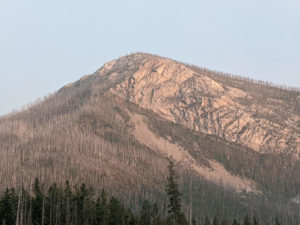
Not many people get to stand on the seafloor. At least, not consciously. When I strode into Montana’s Bob Marshall Wilderness on July 12, 2021, I wasn’t immediately concerned with the long history of the region with my exhilarated attention thoroughly divided between the cliffs and peaks surrounding the Gibson Reservoir and my dusty boots, as I made sure not to misstep on the narrow trail above the glittering, deep blue water.
Later that afternoon, I had a wake-up call. While most of us waded along the reservoir’s shore to cool off, my fellow student Sam poked along the beach in search of interesting rocks. He quickly discovered, and shared with the rest of us, that the beach was a veritable treasure trove of fossilized marine life. Over the next day, we discovered dozens of fossils of all sizes, from perfectly-preserved spiral snail shells to a large, spiral-shaped ammonite. It dawned on me that we were standing on a prehistoric seafloor, pushed east by continental drift, a geological history of millions of years I left completely unconsidered until confronted by direct evidence of its occurrence. It was a humbling thought, but it wasn’t the only hidden history I would be confronted with during my time in the Bob.
Conservation Across Boundaries means transcending social and cultural obstacles in our local, national, and international communities to foster a collaborative, constructive approach to protecting our regional ecologies. But it has a very literal meaning as well. Twenty-eight percent of land in the United States is publicly owned, and jurisdiction of it is divided into a complex patchwork of management between federal agencies like the Forest Service, the Bureau of Land Management, and others, all answering to different departments in our executive branch.
Beyond ideological and financial competition, this eclectic partitioning makes coherent conservation efforts a bureaucratic nightmare ever since its inception in the 19th century amidst an era of rapid westward expansion by white settlers. Even the tracts of land set aside specifically for conservation, our National Parks, are not necessarily based on ecological science. They stem from an earlier era of environmental thinking, where wilderness was romanticized as akin to the Garden of Eden, free of the sins of civilization and industrialization. This view was in some ways espoused by Robert Marshall, the 20th-century forester and environmentalist who serves as the Bob’s namesake. Even nearly a century after the first National Park opened, the 1964 Wilderness Act stated that any area that could be considered ‘wilderness’ had to be ‘untrammeled by man’ to be officially designated as such.
The problem with this ‘myth of the pristine’ is that it disguises the long history of the region and its Indigenous peoples, who ‘trammeled’ the land long before white settlers ever set foot in the Americas. Their history and connection with the land defies the notion of an untouched American wild, and the centuries-long campaign of genocide they were subjected to by American settler colonialism is swept under the patchwork of jurisdictions and artificial boundaries across the country.
So the next time I recreate in the great American outdoors, I’ll remember what land I’m walking on. If approached with a surface-level view, the vistas will be a curtain drawn over history, whether prehistoric, or our much bloodier recent human history.
Owen Helland is an undergraduate student studying Geosciences at the University of Montana. He is originally from Renton, WA.
One Reply to “Seeing Beyond Boundaries By Owen Helland”
Comments are closed.
Succinct and well-written introspection. Look forward to reading more of your writing!